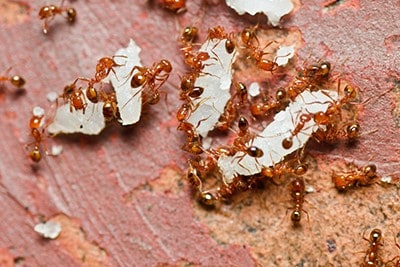Latin Name: Solenopsis Invicta

Also identified as thief ants, they are popular in tropical regions such as Central and South America. They are best known as a red imported fire ant (Solenopsis Saevissma) accidentally introduced into the United States from South America.
Fire ants’ nests consist of a loose mound with open craters for ventilation. Their workers are notorious for damaging planted grain and attacking poultry. They also communicate through chemical secretions and stridulation – sounds produced by rubbing or drumming one body part against another.
Their adult workers are usually aggressive when they are under the threat of attack from neighboring ant colonies and young fire ants.
Their red and black coloration differentiates fire ants. Like any insect, it has a hard exoskeleton and six legs. The worker ants have round heads with mandibles, an armored thorax midsection, and an abdomen made of the pedicle and gaster. Their head is usually copper brown. They have varying sizes from 2 to 6 mm (0.079 to 0.236 in).
Fire ants are prevalent in the tropical regions of South America, the Southern United States, and Hawaii.
Fire ants are social insects. They build their nests by pushing up the soil as they make a tunnel in the earth. They make their nests in almost any kind of soil, especially the open and sunny areas like meadows, pastures, playgrounds, parks, lawns, and agricultural land and wilderness areas. They prefer warm, shaded, and wet surroundings covered with foliage.
Though tiny fire ants do not build large mounds yet, we can find them around potted plants, within electrical boxes, and near irrigation lines. Tiny fire ants find electrical boxes attractive because they are the least disturbed areas in the home.
Fire ants are known to eat greasy and sweet materials like meat. They are also omnivores – they feed on animals and vegetables. Their menu includes carbohydrates, protein, and lipids. Hence, fire ants’ diet includes ticks, honeydew, earthworms, insects, arthropod eggs, and other sweets.
The worker ants cannot ingest solid food particles, so they feed on liquids. However, the last developmental stage of the fire ant larva can convert solid food particles into liquid.
Fire ants can inflict painful stings, killing human beings, especially on any human that disturbs their mounds. Their sting often begins with an intense pinching or burning pain immediately after the sting. Their pain is short-lived and causes instant, severe pain with an itching and skin limitation that lasts anywhere from a few hours to days.
Fire ants also cause electrical equipment causing short circuits and equipment failures.
Their mounds are unsightly añd can damage mowers and combines.
Once you sight the worker and swarmer ants, then knew that you have fire ants in your home. Other signs are their sandy earthen mounds which are only visible after recent rainfall or when neighbors complain of being stung by ants.
A professional pest control service best handles little fire ant control. Why? A professional can remove the queen responsible for reproducing more eggs. Also, it’s hard to take away their food source since they survive on both plants and animals. So, unless you get professional help, they can recover quickly.
However, homeowners can take the following measures:
If you suspect these pests are in or around your home, give us a call for a Free Home Inspection!
